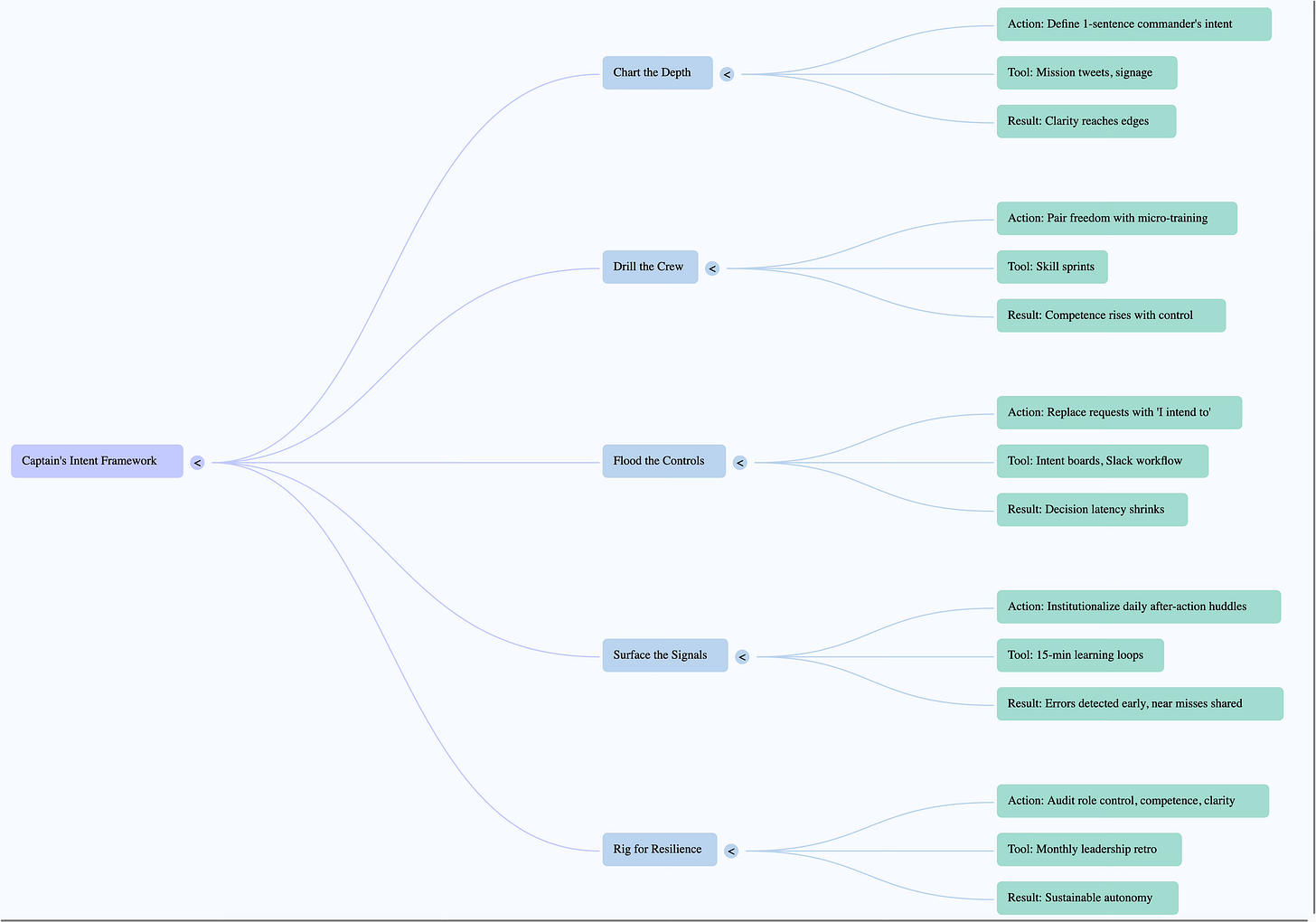Welcome to a new edition of “Students of Leadership,” today reviewing key principles from a book I read several years ago, but that recently a co-worker reminded me of, for which I am very thankful. This is a tribute to her, who showed interest in my writing engaging in stimulating hallway conversations about leadership, books and work.
“Turn the Ship Around,” by David Marquet.
In one sentence, Marquet’s leader‑leader model shows that when you give control while relentlessly building competence and clarity, teams can raise to the top. When you give control without losing control, your team shifts from order-takers to initiative-makers.
The Night an Impossible Order Changed Everything
In December 1999 the nuclear submarine USS Santa Fe was 200 feet deep when Captain David Marquet, still new to the boat, commanded “Ahead two‑thirds, twist‑lock to battery.” The officer of the deck relayed the order even though he knew that—unlike Marquet’s previous sub—Santa Fe had no such setting. The propulsion chief tried to execute, failed, and silence rippled through the control room. Marquet asked why the order had passed. “Because you told me to, Captain.” The epiphany hit: a crew trained to obey couldn’t think when it mattered most. That moment set the stage to work on replacing the current “leader‑follower” culture with a “leader‑leader” one, ultimately turning the fleet’s worst boat into its best, and driving up reenlistments from 3 to 33 sailors in a year.
"The first step in changing the genetic code of any organization or system is delegating control, or decision-making authority, as much as is comfortable, and then adding a pinch more. This isn't an empowerment program. It's changing the way the organization controls decisions in an enduring, personal way.”
What Marquet Discovered Under the Sea
1. Put Control Where the Information Lives
Instead of funneling every decision through a single captain, Marquet shifted authority to the people closest to real-time facts, the sonar operator who hears the contact first, the reactor chief who feels the machinery hum. This very important change transformed 135 obedient “doers” into 135 accountable “thinkers.”
What to do on Monday at work: map your own workflows; ask, “Who actually sees the data first?” Then align on communication expectations and grant those individuals the right -and the obligation- to act without waiting for permission.
2. Autonomy Requires Competence × Clarity
Freedom is not a perk; it is the calculated outcome of two critical multiplying factors: ‘Why’ and ‘How'. The team must know well the Why of things (clarity), and the How of things (competence) before they’re cut loose. Marquet invested heavily in crystal-clear mission intent and in cross-training so sailors would feel confidence to make decisions and ready to improvise safely under stress.
What to do on Monday at work: review how clear you are with your team on what is exactly needed to get done and why, then make sure to pair every responsibility with targeted skill-building and a one-line statement (why) everyone can say in their sleep.
3. Climb the Ladder of Leadership
Language rewires mindset, so orders such as “Request permission to…” became responsible statements of “I intend to…,” signaling total ownership. As this type of ‘intent language’ spread across teams, decision speed soared and errors plummeted.
What to do on Monday at work: tell your team no more “What should I do?” and replace it with “Here’s what I propose and why.” Coach it until it’s the new norm, until it’s common language, until it defines the new identity.
4. Build Mechanisms, Not Messages
Marquet didn’t rely on big inspirational speeches for people to do things differently; he knew that the only way was to hard-code new habits. Pre-mission briefings turned into “certifications” where junior officers had to prove readiness. After-action reviews dissected mistakes without blame, turning every misstep into institutional muscle memory.
What to do on Monday at work replace passive status updates with demonstrable checkouts, and schedule post-project debriefs focused on lessons, not guilt. The culture will sustain itself and over time it will be who they are, no matter if you are still the boss or not.
“The Captain’s Intent” Framework
The chart above illustrates how Marque’s four (4) Leadership Principles can be turned into a framework to facilitate action that speeds up results:
- Chart the Depth (clarity)
- Drill the Crew (competence)
- Flood the Controls (decisions)
- Surface the Signals (transparency)
- Rig for Resilience (autonomy)
Let’s analyze “Drill the Crew” for example.
The Intent is to give more freedom for decisions to be made at every level of the organization. The Tool is called “Skill Sprints,” to incorporate frequent trainings into your leadership practice for up-skilling on technical processes, capabilities, and methodologies; as well as accelerate leadership development through shared best practices, failures, insights and lessons learned. The Result is a group of individuals with high confidence, empowered to act as owners and make decisions at every level of the organization.
“Give control only as fast as you build competence and clarity.” David Marquet
Improvised Practice for the Coming Week
Send One Less Approval Email: Ask your team to reply with “I intend to” instead.
Run a 15‑Minute Skill Sprint: Elevate competence where risk feels highest.
Tweet Your Commander’s Intent: If you can’t fit the “mission” in a short tweet, then it isn’t clear, and that is your problem to solve.
Host a Quiet Hunt: In your next meeting, speak last and delay as much as possible that moment… let insights surface, listen to truly understand.
Score Yourself on the 3 C’s: How are you doing on a scale from 1 to 10 on Control, Competence, and Clarity? Whichever is weakest, pick a fix from the framework.
Call to Action
Leadership myths surface in crises; the only truth is that real leadership empowers ownership and multiply leaders. Look in the mirror and be honest about where you stand on Clarity, Competence, and Control; raise the bar. Make it your mission to score 10/10 on Clarity, and focus relentlessly on increasing Competences and decreasing Control.
Your team, your fleet, is waiting. Turn your ship around.
“Everything I knew about leadership was wrong…
To achieve the highest ideals it’s all about discretionary effort.”
David Marquet
Note: thank you Ami for the idea
P.S. Before I go, here you have “The Treat,” where I share some of the music that kept me company while writing … Enjoy as you bid farewell to this post
“Lead yourself, Learn to live. Lead others, Learn to Build.”
If you enjoyed reading this post consider subscribing to the newsletter for free, joining the community and sharing your thoughts.







A great "deep dive" into the book I recommend to all my leadership clients. I have found it to be particularly helpful for those who are concerned about becoming a "touchy feely" leader.